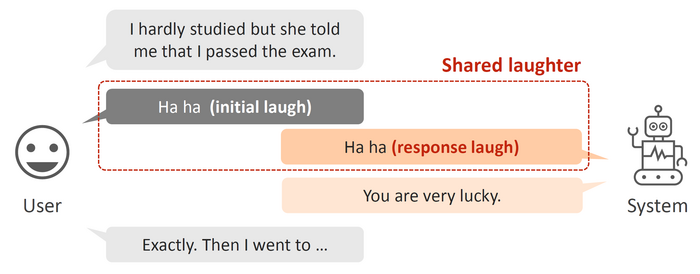Researchers and philosophers have always been mystified by the source of humor. A group of scientists at Kyoto University in Japan are attempting to teach a robot to laugh by engineering an artificial intelligence (AI) that takes in signals via a shared laughter platform.
 An example of a conversation between the researchers and Erica. Image Credit: Inoue et al.
An example of a conversation between the researchers and Erica. Image Credit: Inoue et al.
In a recent issue of the journal Frontiers in Robotics and AI, the researchers illustrate their ground-breaking method for constructing a funny bone for the Japanese android “Erica.”
It is not as if robots cannot identify laughter or even produce a giggle at a bad dad anecdote. Instead, the challenge is to develop the human distinctions of humor for an AI platform to enhance natural talks between robots and people.
We think that one of the important functions of conversational AI is empathy. Conversation is, of course, multimodal, not just responding correctly. So we decided that one way a robot can empathize with users is to share their laughter, which you cannot do with a text-based chatbot.
Dr. Koji Inoue, Study Lead Author and Assistant Professor, Department of Intelligence Science and Technology, Graduate School of Informatics, Kyoto University
A Funny Thing Happened
In the shared-laughter model, to begin with, a human laughs, and the AI system reacts with laughter as an empathetic reply. This method necessitated engineering three subsystems—the first to detect laughter, the second to choose whether to laugh, and the third to decide the type of applicable laughter.
The researchers collected training information by annotating over 80 dialogues from speed dating, a social setting where large groups of people socialize or interact with each other face-to-face for a short time. In this scenario, the lengthy matchmaking involved Erica, the robot, and students from Kyoto University, teleoperated by many amateur actresses.
Our biggest challenge in this work was identifying the actual cases of shared laughter, which isn’t easy, because as you know, most laughter is actually not shared at all. We had to carefully categorize exactly which laughs we could use for our analysis and not just assume that any laugh can be responded to.
Dr. Koji Inoue, Study Lead Author and Assistant Professor, Department of Intelligence Science and Technology, Graduate School of Informatics, Kyoto University
The type of laughter is also significant because, in certain cases, a well-mannered chuckle may be more suitable than a loud burst of laughter. The experiment was restricted to social laughs.
The Robot Gets It
The researchers ultimately tested Erica’s new sense of humor by developing four short 2- to 3-minute dialogues between a person and Erica with her new shared-laughter platform. In the first situation, she only expressed social laughter, followed by cheery laughs in the second and third situations, with a mixture of both types of laughter in the last dialogue.
The researchers also developed two more sets of analogous dialogues as baseline models. In the first set, Erica does not laugh. In the second set, Erica expresses a social laugh every time she detects a human laugh without employing the other two subsystems to screen the context and reaction.
The scientists crowdsourced over 130 people to listen to each situation within the three different circumstances—no laughter, shared-laughter system, all laughter—and assessed the interactions based on human likeness, naturalness, empathy, and understanding. The shared-laughter platform did better than either baseline.
The most significant result of this paper is that we have shown how we can combine all three of these tasks into one robot. We believe that this type of combined system is necessary for proper laughing behavior, not simply just detecting a laugh and responding to it.
Dr. Koji Inoue, Study Lead Author and Assistant Professor, Department of Intelligence Science and Technology, Graduate School of Informatics, Kyoto University
Like Old Friends
There are still plenty of other laughing styles to model and train Erica on before she is ready to hit the stand-up circuit. “There are many other laughing functions and types which need to be considered, and this is not an easy task. We haven’t even attempted to model unshared laughs even though they are the most common,” Inoue noted.
Obviously, laughter is merely one facet of having a normal human-like conversation with a robot.
Inoue continues, "Robots should actually have a distinct character, and we think that they can show this through their conversational behaviors, such as laughing, eye gaze, gestures, and speaking style. We do not think this is an easy problem at all, and it may well take more than 10 to 20 years before we can finally have a casual chat with a robot like we would with a friend."
Journal Reference:
Inoue, K., et al. (2022) Can a robot laugh with you?: Shared laughter generation for empathetic spoken dialogue. Frontiers in Robotics and AI. doi.org/10.3389/frobt.2022.933261.